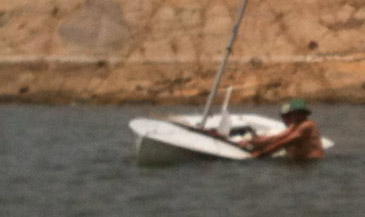
It was the best of days, it was the worst of days.
It was a day of short sails, and long walks.
It was our version of Summer Sailstice 2013.
The day started out well enough. Earlier in the week, I’d excavated the Snipe from 5 years of fossilization in the garage, gathered all the pieces, and even pumped up the trailer tires and put new bulbs in the lights. By the time Rick, my crew, arrived at mid-morning, we were ready to rumble.
When we arrived at the lake around 11 a.m., the wind was already up. The launch area was mostly protected, although you had to watch for the occasional rogue puff. But out in the main part, I could see whitecaps riffling the surface. Playing off our rusty skills, I joked that we might spend more time swimming than sailing.
Really, I meant that as a joke.
Turns out the joke was on us. By the time we put the boat together and shoved off, it was blowing about 15, with a more-than-occasional freight train puff highballing through. Good stuff, and for the first blast reach across the water, we were silver sea gods.
But forces were at work that would soon bring the frivolity to its knees. Then its belly. Then hold it underwater until all movement ceased.
It was literally during the first tack — 10 minutes into the day — that the boat felt . . . not right. It was sluggish through the turn and then almost capsized on the new tack. I retrospect, I should have realized what was happening, because it’s happened to me before.
But I didn’t. Like I said, we were rusty. I just figured we needed more time back in the saddle.
Again, we tore off across the lake. Well, not so much tore as surged. Which is weird because Snipes are not normally “surging” boats. We were sailing, yes, and as far as I could see, trimmed well. But the boat just wasn’t moving like I remembered. Then a big puff hit, and easing the main had absolutely no effect. Over we went.
Well, I knew we were going to get wet. We swam around, climbed onto the centerboard and got her back up, only to capsize the other way. Then swam around and did it again on the other side — with the same result. And again. And again. The boat absolutely would not stay upright long enough to get sailing again, thence to empty itself through the bottom scupper.
What in the world was going on? Was I really that out of practice?
Anyway, that’s pretty much how it went for the next hour or so. We’d get the boat upright, throw our weight around to keep it that way, but as soon as wind hit the sails, over she went. And anyway, the whole transom was underwater, which had never happened before. So how could it drain if the boat was half submerged?
By this time we had gathered a small audience of boats and people watching the two fools in the sailboat. (I'm sure we set local interest in sailing back several decades on this one day alone.) One skipper of a flashy job with a big motor and metalflake paint asked if we wanted a tow, which I at first politely refused. But after awhile fighting what was obviously a losing battle, were getting tired, cold and nowhere. They were still circling, so I finally called them over. I managed to drop the sails and pass them a towline. Rick and I got the boat upright again and climbed in. I was still hoping that the forward momentum might empty us out.
Instead, the transom sank even farther. Rick was steering, so I climbed out on the forward deck to even us out, and then the nose went under. . . and kept going. It was like watching "Das Boot" when the U-boat makes an emergency dive. I shouted for our towing friends to stop as the boat slowly pivoted on her nose and capsized again. This time, try as we might, we could not get it upright long enough to start the tow again.
The good news — finally — was that we were close enough to shore that we could touch bottom. So we thanked our metalflake friends and hauled the mess onto the beach, trying to avoid at least the biggest rocks.
That’s when I finally realized what I had done. Or more specifically, not done. As we hauled the boat as far ashore as we could and tipped it over to spill the water, I noticed the gusher coming from the small hole at the very bottom of the transom. Son of a... I’d forgot to put the plug in! This McLaughlin Snipe has a hollow double bottom, and instead of insuring we remained light and nimble, it was now full of water, insuring we were a near submersible.
It was actually too much water for two guys to get out by ourselves, because we couldn’t get the boat far enough out of the water. It was also too much for two guys and two gals, since by now our better halves had arrived, and they were definitely more irritated about having their tanning session interrupted than happy we were alive.
Geez, we're sorry, okay?
After several ideas to empty the boat were tried and rejected, we all came to pretty much the same conclusion: The only way to empty the boat out was to get it back on the trailer. Since the area where we came ashore was not accessible to vehicles, that meant we had walk the sodden boat back to the boat ramp.
This would not have been that difficult if we were just walking along a beach. But there were several rocky ‘points’ we had to round, as well as various submerged tree stumps, boulders and the occasional broken beer bottle along the way. And the boat still wanted to capsize, which meant that at times we needed a guy below in the water holding the boat and a guy above scaling the rock while holding the mast. Think a mixture of the Bataan Death March and scaling Everest in bare feet.
Yes, okay, it was only a quarter mile or so to the ramp, but trust me on the pain part.
All in all, it wasn’t the way I planned or wanted to spend Summer Sailstice — or any other day. But there are always silver linings. We did make it back with the boat in one piece, got it on the trailer and got it emptied out — it took 25 minutes to drain through the half-inch hole.
We lost only some water bottles, a cushion and one flip-flop. Aside from various scrapes and scratches, the boat and gear was not damaged and there was only one small tear in the jib that is easily repairable.
Unfortunately, we could not say the same for our legs, which looked like someone had taken a cheese grater to them. But even that made me happy in a way — thank goodness there are no fresh water sharks!
Plus, I was amazed that the boat didn’t sink. Rick is a numbers guy and later did a rough calculation that the boat had taken on almost 700 pounds of water in the double bottom. The hull itself is foam cored, but if I were a betting man, I would have put money on the 'glass and metal parts outweighing the foam core, and our day on the lake having ended being a literal downer. Glad I was wrong about that, too.
Lessons learned? Well, the obvious one: don’t forget the freakin’ plug. That could not be more indelibly ingrained at this point if they tattooed it into my brain with a hot branding iron.
But I think we also addressed a larger issue here, and finally answered an important question that surely somebody, somewhere, sometime, has asked: No, Virginia, submarines can't sail.

How Snipes are supposed to look on a good day. Photo: Craig Storms
